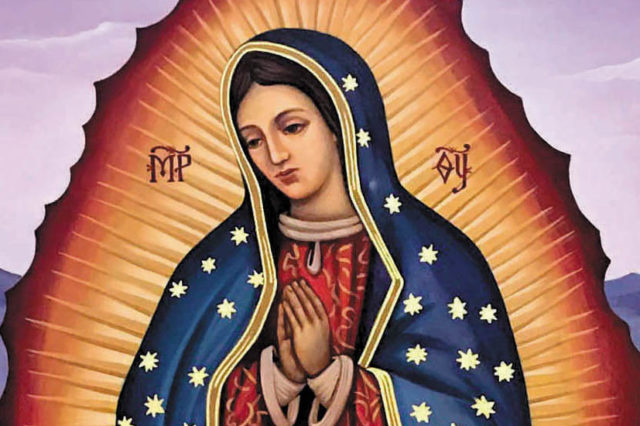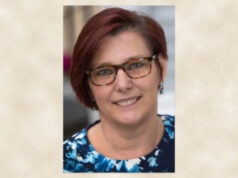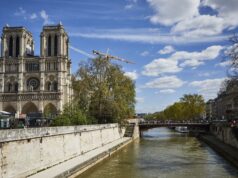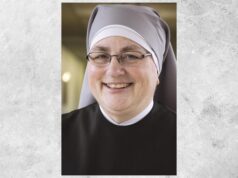I couldn’t believe my ears. I had just opened the door to the church and I was hearing strains of Beethoven’s Moonlight Sonata. It was Beethoven being played on a cold December afternoon in a church built in the middle of a Wisconsin farm field. How wonderful! And then I was confused.
We were preparing to celebrate the feast of Our Lady of Guadalupe in conjunction with the Second Sunday of Advent. There at the piano was my altar server, a young man whose parents are Spanish-speaking and who speaks both English and Spanish perfectly well. And playing, of all things and on all days, the Moonlight Sonata!
I walked into the church and sat on the far side and simply listened to the glorious sound. As my eyes traveled around the church, now tastefully decorated for the occasion, I was struck by how beautiful things looked. The Spanish-speaking congregation, mostly from Mexico, had spent all night decorating. In the front, off to the side, was the Virgin of Guadalupe’s image, decorated with lights and flowers — and their humble devotion.
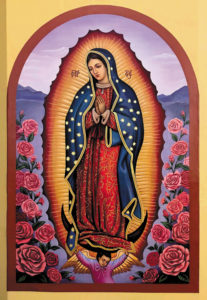
This was only my fifth month of saying Mass in Spanish and I felt very unworthy to be leading these faithful people in a language that was not my own. What if I said the wrong thing? What if I swore — by accident? What if I screamed and ran away?
A year earlier, I had innocently volunteered to go away for a few months to study Spanish and now I needed to really know what I was doing. I asked the Blessed Virgin to pray for me as the winter sun shone brightly through the church windows.
Suddenly, I heard loud chanting and shouts. The Moonlight Sonata abruptly ended and bursting through the church door came a small group of parishioners. They were dressed in native dress carrying a statue of Mary and a large banner. They were chanting, “Estamos tristes, no, no! Estamos muy contentos, si, si.” They were indeed not sad, but exuberant. Their faces reflected the radiance of their faith.
Extemporaneously, they shouted prayers of praise to the Virgin, applauded, embraced and then departed. “How quaint,” I thought. I returned to my prayer for only a moment and then I again heard far-off shouts. Yet another group emerged with radiant faces, having walked for miles on pilgrimage to the Virgin. “Estamos tristes, no, no!” They, too, were so very, very happy.
I felt myself rise to my feet in reverence to their devotion. I had never seen such a thing before in my 42 years of life. Such raw devotion, such pure zeal, such love for the faith! Still another group came carrying a U.S. and Mexican flag, having also walked on pilgrimage through the snow and below freezing temperatures. This continued for over half an hour.
By this time, the church had begun to fill. As I walked to the sacristy to prepare for Mass, a parishioner urged me to return to the church for the “dancers.” I admit that a sense of horror flashed through my mind from previous liturgical trauma, but I was so intrigued by the whole thing I went to watch.
There came the young women of the parish with their mothers, resplendent in ethic dress, dancing in front of the image of the Virgin of Guadalupe. They danced and smiled. Nobody applauded after the dances, such demonstrations of veneration seemed to be — well, expected. It was Our Lady of Guadalupe. Of course, she deserves such love.
The time for Mass came and the church was now overflowing. The people looked like they were celebrating Christmas and Easter and the second coming of Christ all together. I was able to make my way through Mass in Spanish. Then came the eucharistic prayer and the moment of consecration. To my surprise, the people called out not once, but twice: “My Lord and My God” or other pious sayings. I found myself silently saying the same.
After holy Communion came a brief award ceremony for the best child’s rendition in art of Our Lady of Guadalupe. This must have been difficult to decide, since seemingly half the congregation appeared to be under the age of 18. As I processed out after the final blessing, a Mariachi band appeared “ex nihilo” and proceeded to play for the next 15 minutes in the church. It was wonderful. And it was real.
Making my thanksgiving after Mass, I asked God a question: “Who are all these people?” And then it came to me. “These people” are “those people” who we hear about in the news and during our political debates. “Those people” are these people — God’s people, who have come to this country in search of a better life. They work in farms and factories. They work as cooks and cleaners. Just like my Italian ancestors did 100 years ago.
This must have been what the ethnic experience was like for most of our ancestors — an experience that was honed, shaped and amalgamated into the American melting pot. This must have been what it was like — a group of people, mostly poor, many fearful, gathering together to share the most important thing in the world to them: their Catholic faith — and forming a community from this common experience. I thanked God for the privilege of witnessing this experience.
From a German classical music composer, to a Mexican Marian devotion, to a Wisconsin farming community’s parish church in the cold of winter, to a third-generation Italian-American priest. All of these seemingly random and disparate facts can only be held together in one, singular way. This is the Catholic Church — our church — and we are all blessed to be children of the same heavenly Father.
— By Father John Girotti
Father Girotti serves as vicar for canonical services and associate moderator of the curia for the Diocese of Green Bay, Wisc., and is author of “A Shepherd Tends His Flock.” This column first appeared in The Compass, newspaper for the Diocese of Green Bay.


